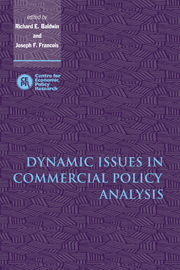Book contents
- Frontmatter
- Contents
- List of figures
- List of tables
- Preface
- List of conference participants
- 1 Introduction
- 2 Transition dynamics and trade policy reform in developing countries
- 3 Putting growth effects in computable equilibrium trade models
- 4 Innovation, capital accumulation, and economic transition
- 5 Multinational production, skilled labour, and real wages
- 6 Economic policy and the manufacturing base: hysteresis in location
- 7 Trade liberalization and investment in a multilateral framework
- 8 Investment creation and investment diversion: simulation analysis of the Single Market programme
- 9 Blueprints, spillovers, and the dynamic gains from trade liberalization in a small open economy
- 10 Trade policy and North–South migration
- 11 Long-term modelling of trade and environmental linkages
- 12 Labour markets and dynamic comparative advantage
- Index
2 - Transition dynamics and trade policy reform in developing countries
Published online by Cambridge University Press: 13 January 2010
- Frontmatter
- Contents
- List of figures
- List of tables
- Preface
- List of conference participants
- 1 Introduction
- 2 Transition dynamics and trade policy reform in developing countries
- 3 Putting growth effects in computable equilibrium trade models
- 4 Innovation, capital accumulation, and economic transition
- 5 Multinational production, skilled labour, and real wages
- 6 Economic policy and the manufacturing base: hysteresis in location
- 7 Trade liberalization and investment in a multilateral framework
- 8 Investment creation and investment diversion: simulation analysis of the Single Market programme
- 9 Blueprints, spillovers, and the dynamic gains from trade liberalization in a small open economy
- 10 Trade policy and North–South migration
- 11 Long-term modelling of trade and environmental linkages
- 12 Labour markets and dynamic comparative advantage
- Index
Summary
Introduction
There is now a sizeable theoretical literature linking international trade with endogenous growth. This literature attempts to provide formal mechanisms for the interplay between trade policies and income growth, without recourse to exogenous assumptions regarding the sources of growth. The empirical foundations for believing in such a linkage seem compelling, with numerous studies reporting a positive correlation between an ‘open’ trade regime and growth. However, although there appears to be a positive linkage between openness and growth, and although this linkage seems to work indirectly through investment (see, e.g., Levine and Renelt (1992) and Baldwin and Seghezza (1996)), the results of the cross-country literature do not offer strong evidence of an endogenous growth mechanism at play. Endogenous growth models predict permanent growth effects following policy regime changes, the existence of which cannot be detected through standard cross-country correlation analysis. Moreover, the recent studies that test directly for the implications of endogenous growth models have so far failed to establish anything but a transitory impact from policy reforms on growth rates (see Jones (1995)).
In parallel with the development of the new endogenous growth theory, some authors have gone back to take a second look at classical growth theory, associated foremost with Solow (1956). They have found that an augmented version of the Solow growth model that includes accumulation of human capital as well as physical capital provides a surprisingly good description of the cross-country data.
For example, Mankiw, Romer, and Weil (1992) have found evidence of ‘conditional convergence’, that is, convergence in income per capita across countries controlling for differences in savings rates, human capital, population growth, and other variables that predestine countries for different steady-state incomes.
- Type
- Chapter
- Information
- Dynamic Issues in Commercial Policy Analysis , pp. 14 - 43Publisher: Cambridge University PressPrint publication year: 1999
- 4
- Cited by



